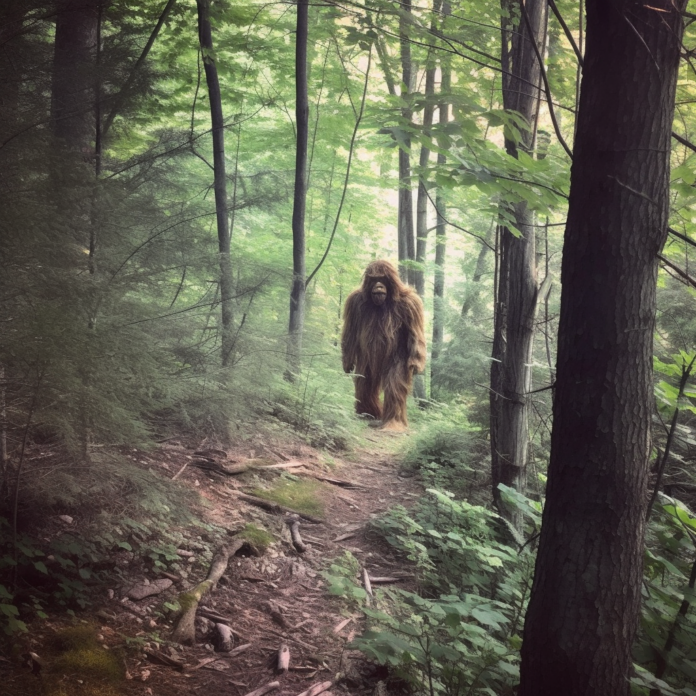
Fringe Score: Plausible but unconfirmed – intriguing anecdotes and alleged evidence but no definitive proof.
Summary:
Bigfoot, also known as Sasquatch, is an alleged large, hairy, bipedal hominid believed to inhabit remote forests in North America. Reports of Bigfoot sightings, footprints, and other encounters have persisted for centuries, capturing the public’s imagination and fueling cryptozoological investigations. While no concrete evidence of Bigfoot’s existence has been confirmed, the numerous anecdotes and supposed physical traces make it a plausible yet unproven phenomenon at Fringepedia.

History:
Accounts of Bigfoot-like creatures can be found in various indigenous cultures’ folklore throughout North America, with stories of tall, hairy, human-like beings living in the wilderness. European settlers in the 1800s began to report similar sightings, and the phenomenon gained widespread attention in the 20th century as stories and alleged evidence circulated in newspapers and popular media.
The term “Bigfoot” was coined in the 1950s when a series of large footprints were discovered in Bluff Creek, California. This event sparked increased interest in the creature, and Bigfoot has since become a popular figure in North American folklore and pop culture.
Alleged Evidence:
Over the years, various types of evidence have been put forth in support of Bigfoot’s existence, including:
- Sightings: There have been numerous eyewitness accounts of Bigfoot sightings in North America, especially in the Pacific Northwest, Canadian wilderness, and the Appalachian Mountains. However, sightings are often brief and descriptions can vary, making it difficult to verify their authenticity.
- Footprints: Large, unexplained footprints have been discovered in remote locations, and some cryptozoologists claim that these are evidence of Bigfoot. Critics argue that many of these prints could be
- hoaxes or misidentified animal tracks.
- Photos and videos: Various photographs and video footage, such as the famous Patterson-Gimlin film from 1967, claim to depict Bigfoot. However, the quality of these images is often poor, and many have been dismissed as hoaxes or misidentifications.
- Hair and scat samples: Hair and scat samples have been collected and attributed to Bigfoot, but DNA analysis has either been inconclusive or linked these samples to known animals.
- Vocalizations: Some individuals have reported hearing unusual vocalizations in areas where Bigfoot sightings have occurred. These sounds are often described as howls, screams, or grunts. While intriguing, it is difficult to definitively link these sounds to an unknown creature.
hoaxes or misidentified animal tracks.
- Photos and videos: Various photographs and video footage, such as the famous Patterson-Gimlin film from 1967, claim to depict Bigfoot. However, the quality of these images is often poor, and many have been dismissed as hoaxes or misidentifications.
- Hair and scat samples: Hair and scat samples have been collected and attributed to Bigfoot, but DNA analysis has either been inconclusive or linked these samples to known animals.
- Vocalizations: Some individuals have reported hearing unusual vocalizations in areas where Bigfoot sightings have occurred. These sounds are often described as howls, screams, or grunts. While intriguing, it is difficult to definitively link these sounds to an unknown creature.
Skeptical Arguments:
Skeptics argue that the lack of concrete evidence for Bigfoot, such as a specimen or indisputable photographic evidence, makes the phenomenon unlikely. Additionally, they point to the following factors:
- Hoaxes: Some alleged Bigfoot evidence has been revealed as hoaxes, casting doubt on other purported findings.
- Misidentification: Skeptics argue that many sightings and supposed evidence could be the result of misidentifying known animals, such as bears, or natural phenomena.
- Ecological concerns: Some scientists question the plausibility of a large, undiscovered primate species in North America, given the lack of a known breeding population and the ecological impact such a species would have on its environment.
Conclusion:
While the existence of Bigfoot remains unconfirmed, the intriguing anecdotes and alleged evidence make it a plausible, albeit unproven, phenomenon. At Fringepedia, we maintain an open mind to the possibility of Bigfoot, but recognize that definitive proof is still lacking. Until more concrete evidence emerges, Bigfoot will continue to be a fascinating subject of speculation and debate in the realms of cryptozoology and popular culture.





